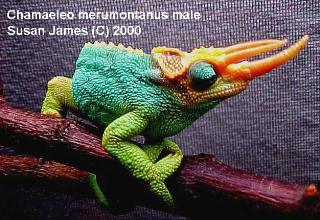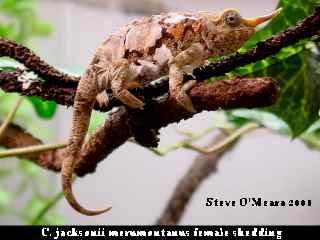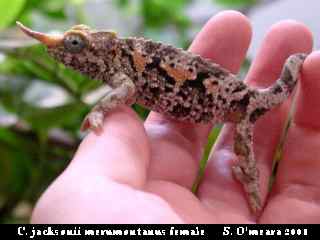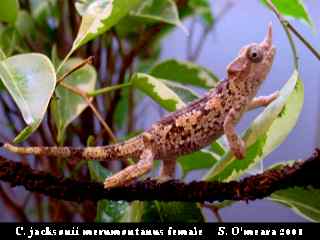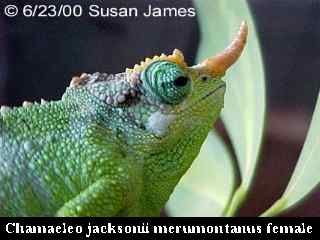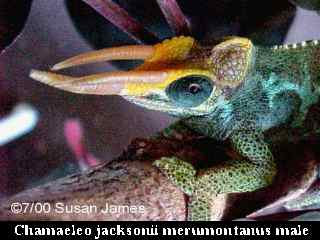 |
|
| Chamaeleo
(Trioceros) jacksonii merumontanus |
| Scientific name |
Common name(s) |
alternate scientific names |
described by |
year |
size |
brood |
|
Chamaeleo (Trioceros) jacksonii merumontanus
|
Mt. Meru or Dwarf Jackson's Chameleon |
Chamaeleo jacksoni merumontana
see a species list of Chamaeleo |
Rand |
1958 |
Small |
Live |
C. j. merumontanus
(also known as the Mt. Meru or dwarf Jackson's chameleon) inhabits the mid to high elevations of Mt. Meru and the Arusha district of Tanzania. Smaller than C. j. jacksonii and xantholophus, C.j. merumontanus males are longer and more slender than females, and can reach a total length of 6 - 8 inches, with a SVL of 3 -4 inches. Females are slightly smaller, yet appear to be "bulkier" than males. Average weight of adults ranges from 25 to 35 grams.
Males are highly aggressive toward conspecifics and at times can be moderately aggressive towards keepers. Females are generally timid. All should be housed separately. Cohabitation is tolerated for a short time for mating purposes.
Coloration: Males are more colorful than females with a yellow head, blue–green flanks and eye turrets (which are sometimes a beautiful sky-blue), green legs and tail. Females range from brown at times to olive green, or a complete lime green. Stress coloration is dark brown, often with triangular patterns along the flanks. Scale pigmentation of the parietal crest is dark or dusky, similar to that of C. j. jacksonii, however, the scales are smooth like that of C. j. xantholophus. The dorsal crest can range from dark to yellow and runs the length of the trunk. Gular and ventral crests are absent.
Males possess 3 prominent horns that are quite long in proportion to their body and are considered to be fairly fragile. Females possess a rostral horn and either rudimentary or no preocular horns. Many wild caught, imported females are lacking the rostral horn possibly due to the importation process or even natural causes, which results in a short wedge. Males exhibit a tail base swelling.
Being native to montane rainforests with an average rainfall of over 50 inches, they require high humidity and cool temperatures in the low to mid 70ºs (F) with a basking spot in the low 80s. Nighttime temperatures in the 50s are tolerated as long as they are able to warm up to the 70s during the day. It is recommended to have at least a 10 degree F drop during the night. 3 mistings per day lasting 3-5 minutes each should be provided and supplemented by a drip system. An all screen enclosure should be used to allow for proper airflow as well as temperature gradients. Glass aquaria should be avoided. C. j. merumontanus is a very active chameleon so plenty of climbing areas should be provided to allow for natural behaviors like basking and hunting. The cage should be well planted to allow for privacy but keep the top clear; failing to do so will result in the chameleon constantly roaming the top of its cage, upside-down.
Sexual maturity is reached at anywhere from 7 - 10 months but it is advised to wait until they are 12 months old for breeding. Gestation can take 5 to 7 months. Introduction of a female into a male's cage will result in the male's constant head jerking and brighter coloration. A receptive female will become light, olive-green, elevate her tail base, and allow male to mount. A non-receptive female's color will darken and she will gape and sway from side to side. A gravid female will have a very round appearance. It is rare for the mothers of this subspecies to do any harm to their babies but they still need to be removed from her cage and into their own. Separate the young by size to avoid stress and competition for food. Females give birth to 3 - 10 young which feed eagerly on fruit flies within 24 hours of birth, and eventually, on pin head crickets. Prior to birth it is highly recommended to have many fruit fly cultures already producing flies. Babies are less tolerant of heat combined with low humidity so lower temperatures are recommended. Like adults, the babies are also avid baskers. In addition, plenty of light should be available, including a fluorescent UV light source. Care in misting is essential as asphyxiation is possible. A dripper is a must as the babies tend to be "water droplet shooters" rather than "leaf lappers". Babies will have an overall brown coloration with reddish triangular patterns along flanks. Sex can be determined by horn development at 2 months. Two clutches per year are possible. Despite the reported ability of females to store sperm, a female will rarely produce a viable clutch without a recent copulation.
Contributed by Steve O'Meara
References
Bartlett, R. D. and Bartlett, P. 1995.
Chameleons: A Complete Pet Owner's Manual. Barron's Educations Series, Hauppuage, NY
Davison, Linda J. 1997. Chameleons: Their Care and
Breeding. Hancock House Publishers, Blaine, WA.
De Vosjoli, P. and Ferguson, G. 1995. Care and Breeding of Chameleons. Advanced Vivarium Systems, Santee, CA.
Klaver, C. & W. Boehme. 1997. Chamaeleonidae.
Das Tierreich, 112: i-xiv' 1 - 85. Verlag Walter de Gruyter & Co., Berlin, New York.
Le Berre, F. 1994. The New Chameleon Handbook. Barron's Educational Series.
Martin, J., 1992. Masters of Disguise: A Natural History of Chameleons. Facts On File, Inc., New York, NY.
Necas, P. 1999. Chameleons: Nature's Hidden Jewels. Krieger Publishing Company, Malabar, FL.
Spawls,
S., Howell, K., Drewes, R., and
Ashe, J. 2002. A Field Guide
to the Reptiles of East Africa. Academic Press, New York.
|
|
|
|
|
click on any thumbnail for a larger image
|
|
This page last modified on: Wednesday, November 27, 2002
|
© 2002-2005 ADCHAM.com
ADCHAM logo illustrated by Randy Douglas. Web site design by Look Design, Inc.
Do not reproduce or redistibute any of content of this web site without express written permission from the authors.
|
|
|

